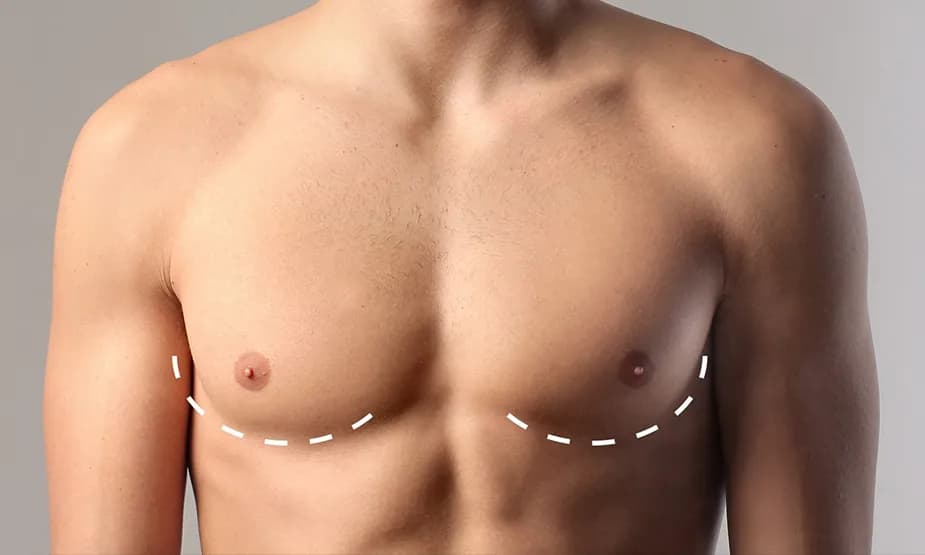Gynecomastia is a condition marked by abnormal enlargement of male breasts. This occurs when there’s an imbalance of testosterone and estrogen hormones. Certain medications and diseases can also cause male breast tissue to swell and get bigger. As this condition can cause discomfort and embarrassment for many men, some consider breast reduction surgery.
What is Gynecomastia?
Gynecomastia is the medical condition in which men or boys develop enlarged or overdeveloped breasts. Gynecomastia is particularly prevalent amongst adolescent boys and men aged between 50 and 70. In adolescence it can occur due to hormonal changes during puberty, in older men it could be linked to declining testosterone levels, and in some cases, obesity can lead to an increase in estrogen which subsequently triggers breast growth. Many will seek Gynecomastia surgery to reduce their unwelcome breast tissue and gain back their self-confidence.

What causes gynecomastia?
An imbalance between estrogen and androgen hormones typically causes gynecomastia. The male body usually produces small amounts of estrogen, the hormone that controls breast growth, but if too much is produced or you have low testosterone, your breasts may enlarge. In some cases, obesity may cause breast enlargement due to excess fatty tissue. Certain conditions can cause male breast enlargement, including:
Adrenal tumors
Alcoholism
Kidney disease or kidney failure
Klinefelter syndrome (an inherited condition)
Liver disease
Thyroid disease
Gynecomastia can result from taking medications to treat:
Anxiety and depression
Bacterial and fungal infections
Enlarged prostate
Heartburn and peptic (stomach) ulcers
Heart failure and high blood pressure
Male infertility (by taking human chorionic gonadotropin, or HCG)
Substance abuse (by taking methadone)
These drugs also can cause breast swelling:
Amphetamines, marijuana, and opioids
Anabolic steroids used to build muscle
Lavender oils and tea tree oils (found in herbal supplements and skin care products)
Treatment options include:
Medication to adjust a hormone imbalance
Surgery to remove the excess breast tissue

What are the symptoms of gynecomastia?
Gynecomastia may develop in one or both breasts. This condition may start as a lump of fatty tissue beneath the nipple and may be sore. These lumps often get larger unevenly. Since the symptoms of Gynecomastia may look like other medical conditions, it’s best to see a healthcare provider for a diagnosis.
Why do men choose a male breast reduction surgery?
Since most male clothing options reveal whether a man has gynecomastia, and it’s common to go shirtless during the summer, it makes it harder to conceal the growth. As the stigma surrounding cosmetic and corrective plastic surgery is steadily declining, the option of surgery is more accessible and socially accepted for men. Due to media, people’s access to information has increased which gives men the option to research the procedure, see before and after pictures, and make an informed decision.
Why is Gynecomastia becoming more common?
Increased Awareness and Understanding
Advances in Surgical Techniques
Societal Pressure and the Desire for an Ideal Body Image
Increased Prevalence of Gynecomastia

Gynecomastia recovery and aftercare
The post-operative scarring after Gynecomastia is typically minimal. You can ask your surgeon guidance for on scar management to assist in the healing process and ensure optimal results. Although the recovery period may vary, most patients can return to their regular activities within a week or sooner following surgery.
Conclusion
In conclusion, the increasing prevalence of gynecomastia is a significant health concern that warrants attention. This condition, characterized by the enlargement of male breast tissue, is becoming more common due to various factors such as obesity, hormonal imbalances, certain medications, and aging. The rise in cases underscores the need for increased awareness, early diagnosis, and effective treatment strategies. It's crucial to remember that while gynecomastia can cause emotional distress, it is typically benign and treatable. As we continue to understand the complexities of this condition, it is hoped that more men will seek medical advice and treatment, leading to improved quality of life for those affected.
Read more: